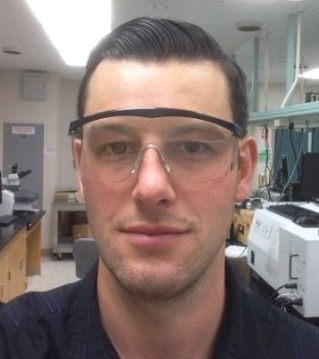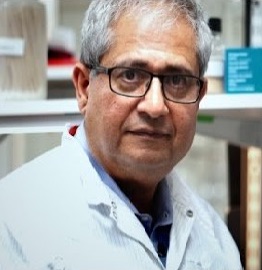Org. Synth. 2017, 94, 303-312
DOI: 10.15227/orgsyn.094.0303
Preparation of Sodium Heptadecyl Sulfate (Tergitol-7i)
Submitted by Brent A. Banasik*
1 and Mansour Samadpour
1
Checked by Felix Pultar and Erick M. Carreira
1. Procedure (Note 1)
A.
Sodium heptadecyl sulfate (Tergitol-7i) (2). An oven-dried 250-mL, three-necked, round-bottomed flask is equipped with an overhead mechanical stirrer with a 20 x 70 mm Teflon paddle (
Note 2), a glass thermometer fitted with glass adapter, and a 10-mL graduated pressure-equalizing addition funnel topped with a rubber septum with a nitrogen inlet needle (
Note 3) (Figure 1).
Figure 1. Reaction assembly
The flask is charged with
1-heptadecanol (
1) (7.50 g, 29.2 mmol) (
Note 4) by briefly removing the glass fitted thermometer, fitting a plastic funnel, and adding in one lot followed by 40 mL of
chloroform (
Note 5) via syringe through the addition funnel septum. The suspension is completely dissolved by immersing the flask in a warm water bath and stirring at 30 °C (internal temperature) for 30 min. The resulting solution is cooled to 6 °C (internal temperature) via ice water bath and
chlorosulfonic acid (2.05 mL, 3.58 g, 30.7 mmol, 1.05 equiv) (
Note 6) is added dropwise via graduated addition funnel to the slurry at such a rate so as to maintain the internal temperature between 5 °C and 12 °C (
Note 7). The walls of the addition funnel are rinsed with two 2-mL portions of dry
CHCl3 delivered via syringe. The ice bath is removed and the reaction mixture stirred at ambient temperatures (~22 °C) for an additional 3 h to become a yellow liquid (Figure 2).
Figure 2. Appearance of reaction mixture stirring at 22 °C
The glassware is then dismantled, and the round-bottomed flask is sealed with septa and placed in a cold room (5 °C) overnight to produce a mass of crystals (
Note 8) (Figure 3).
Figure 3. Appearance of purple-brown crystal mass
The crystals are briefly pulverized with a spatula then vacuum filtered (
Note 9) through a 9 cm Büchner funnel with Machery-Nagel MN 615 filter paper in a cold room or refrigerator. The light brown solids are dried
in vacuo 15 h (
Note 10) and recrystallized from a <5 w/w% basic ethanolic solution of
NaOH (aq) (Notes
11 and
12) to afford a light brown gum that is washed with ice-cold absolute
EtOH (2 x 20 mL). The light brown solids were recrystallized with absolute
EtOH (
Note 13) and washed with ice cold
EtOH (2 x 20 mL) to afford the title compound
sodium heptadecyl sulfate (
Tergitol-7i) (
2) (7.73-7.81 g, 74-75% yield) as a pure (>97% by qNMR) fine off-white powder upon pulverization (Notes
14,
15 and
16) (Figure 4).
Figure 4. Appearance of Tergitol-7i®
2. Notes
1. Prior to performing each reaction, a thorough hazard analysis and risk assessment should be carried out with regard to each chemical substance and experimental operation on the scale planned and in the context of the laboratory where the procedures will be carried out. Guidelines for carrying out risk assessments and for analyzing the hazards associated with chemicals can be found in references such as Chapter 4 of "Prudent Practices in the Laboratory" (The National Academies Press, Washington, D.C., 2011; the full text can be accessed free of charge at
https://www.nap.edu/catalog/12654/prudent-practices-in-the-laboratory-handling-and-management-of-chemical). See also "Identifying and Evaluating Hazards in Research Laboratories" (American Chemical Society, 2015) which is available via the associated website "Hazard Assessment in Research Laboratories" at
https://www.acs.org/content/acs/en/about/governance/committees/chemicalsafety/hazard-assessment.html. In the case of this procedure, the risk assessment should include (but not necessarily be limited to) an evaluation of the potential hazards associated with
1-heptadecanol,
chloroform,
chlorosulfonic acid,
sodium hydroxide,
calcium sulfate,
calcium chloride,
anisaldehyde,
methanol,
acetonitrile, and
ethanol.
2. Mechanical stirring is preferred to magnetic stirring because a precipitate forms at 5 °C (internal temperature) during the addition of
chlorosulfonic acid.
3. The reaction glassware was dried in an oven (135 °C) overnight, cooled in desiccator (
calcium sulfate), assembled and flushed with nitrogen atmosphere that is maintained throughout the duration of the reaction.
4.
1-Heptadecanol (97%) was purchased from Acros Organics and used as received.
1-Heptadecanol was weighed out and added directly to the reaction chamber.
5.
Chloroform (HPLC grade) was purchased from Fisher Scientific and purified by distillation from
CaCl2 under inert nitrogen atmosphere prior to use.
6.
Chlorosulfonic acid (99%) was purchased from Sigma-Aldrich and used as received. The
chlorosulfonic acid stock bottle was quickly capped with a septum and carefully transferred to the addition funnel via gas-tight glass syringe under an inert argon atmosphere.
7. The addition of
chlorosulfonic acid required 10 min for this scale reaction.
8. The reaction mixture darkened at 5 °C overnight to a purplish-brown color and was almost completely solidified due to formation of a crystalline matrix.
9. The solids are gummy when wet and filter very slowly. The filtration via 9 cm Büchner funnel with Machery-Nagel MN 615 filter paper took roughly 15 min at 5 °C with ~35 mmHg vacuum on this scale.
10. The filter funnel and solids were placed upright directly into the vacuum desiccator with
NaOH pellets as a desiccant and sealed under high vacuum of ~0.02 mmHg overnight.
11.
Sodium hydroxide solution (<5 w/w%) is prepared by dissolving
NaOH pellets (2.34 g, 58.5 mmol, 2 equiv) in a mixture of 1.25 mL DI H
2O plus 125 mL anhydrous absolute
EtOH.
Sodium hydroxide (
NaOH) certified ACS pellets were purchased from Fisher Scientific and used as received. Anhydrous absolute
EtOH (200 proof) was purchased from Fisher Scientific and used as received.
Sodium hydroxide is quickly weighed out on weigh paper and added to a 250-mL oven dried Erlenmeyer flask that contains a Teflon-coated magnetic stir bar. Ethanol is measured via graduated cylinder then poured into the flask containing
NaOH and water, lightly capped, then stirred while slowly heating the solution to 75 °C. Dissolution and heating required 40 min on this scale.
12. The crude solid is dissolved in 125 mL of hot (75 °C) <5 w/w% ethanolic
sodium hydroxide solution (see
Note 11) in an oven-dried 250-mL Erlenmeyer flask and sealed with a rubber septum. The solution is allowed to cool to room temperature then placed in a cold room (5 °C) overnight. The resulting crystal mass is broken apart with a spatula and collected by suction filtration (see
Note 9) and dried
in vacuo (see
Note 10) to become powder upon pulverization.
13. The crude, light brown solid is dissolved in 125 mL of hot (75 °C) anhydrous absolute ethanol in an oven-dried 250-mL Erlenmeyer flask and sealed with a rubber septum. The solution is allowed to cool to room temperature then placed in a cold room (5 °C) overnight. The resulting crystals are collected by suction filtration (see
Note 9) and dried
in vacuo (see
Note 10) to afford white powder upon pulverization.
14. A second reaction provided 7.81 g (75%) of the identical product.
15. The product has been characterized as follows: R
f (EtOAc/MeOH/CH
3CN/H
2O = 25:20:4:1, visualized by
p-anisaldehyde stain, visible as weak blue spot on Merck silica gel 60 F
254)
=
0.85; mp (
EtOH):
197-199 °C;
1H NMR
pdf(DMSO, 400 MHz) δ: 0.84 (t,
J = 6.9 Hz, 3H), 1.23 (bs, 28H), 1.47 (pseudo-pentet,
J = 6.8 Hz, 2H), 3.66 (t,
J = 6.7 Hz, 2H);
13C NMR
pdf(DMSO, 100 MHz) δ: 14.0, 22.1, 25.6, 28.7, 28.8, 29.0, 29.1, 31.3, 65.5; HRMS (ESI):
m/z calc. for C
17H
35Na
2O
4S [M + Na]
+ 381.2046, found 381.2057; IR (ATR, neat):
ṽ = 2916 (vs), 2850 (s), 1472 (m), 1255 (m), 1082 (s), 822 (s), 716 (m), 635 (m), 624 (m), 594 (m) cm
-1.
16. The purity of the compound (15.7 mg) was determined to be 99.6% by quantitative NMR
pdf(qNMR) spectroscopy (300 MHz,
T1 = 10 s, number of scans = 8) with 1-naphthol (12.6 mg, purchased from Acros Organics and used as received, 99+%) as the internal standard.
Working with Hazardous Chemicals
The procedures in
Organic Syntheses are intended for use only by persons with proper training in experimental organic chemistry. All hazardous materials should be handled using the standard procedures for work with chemicals described in references such as "Prudent Practices in the Laboratory" (The National Academies Press, Washington, D.C., 2011; the full text can be accessed free of charge at
http://www.nap.edu/catalog.php?record_id=12654). All chemical waste should be disposed of in accordance with local regulations. For general guidelines for the management of chemical waste, see Chapter 8 of Prudent Practices.
In some articles in Organic Syntheses, chemical-specific hazards are highlighted in red "Caution Notes" within a procedure. It is important to recognize that the absence of a caution note does not imply that no significant hazards are associated with the chemicals involved in that procedure. Prior to performing a reaction, a thorough risk assessment should be carried out that includes a review of the potential hazards associated with each chemical and experimental operation on the scale that is planned for the procedure. Guidelines for carrying out a risk assessment and for analyzing the hazards associated with chemicals can be found in Chapter 4 of Prudent Practices.
The procedures described in Organic Syntheses are provided as published and are conducted at one's own risk. Organic Syntheses, Inc., its Editors, and its Board of Directors do not warrant or guarantee the safety of individuals using these procedures and hereby disclaim any liability for any injuries or damages claimed to have resulted from or related in any way to the procedures herein.
3. Discussion
Surfactants are valuable synthetic intermediates that are widely used in organic synthesis,
2 microbiology,
3 fuels,
4 and many household products.
5 Tergitol-7i (
2) is a decidedly important surfactant for the selective inhibition of gram-positive bacteria and enumeration of coliforms, such as
Escherichia coli, in food and water samples
6 (for example, as a key component in Chapman's agar medium)
7; however, a thorough procedure for its preparation is not represented in chemical literature and modern detergent synthesis protocols are somewhat arbitrary. It is of further significance that although
Tergitol-7i is available for purchase, it is rather expensive (Sigma-Aldrich, $100 USD/100 mg, 2016) and our preparation is economical (~$4 USD/100 mg) and scalable from affordable
1-heptadecanol (
1) starting material. Fatty alcohols, such as
1-heptadecanol, are good starting materials for detergent syntheses due to commercialization of catalytic dehydrogenation
8 of fatty acids and advances in petrochemical polymerization synthesis.
9As described above, the bioactive detergent,
sodium heptadecyl sulfate (Tergitiol-7
i) (
2), was produced from
1-heptadecanol (
1) in good yield (74- 75%) with a high level of purity (>97+%) and for a fraction of the cost of commercially available
Tergitol-7i. Furthermore, synthetic
Tergitol-7i (
2) has good bioactive efficacy for our in-house selective medium thin-film assay (Figure 5). Additionally, this procedure is applicable to a wide range of gram-scale detergent syntheses and various research interests.
Figure 5. Enumeration of E. coli via gram-positive inhibitor sodium heptadecyl sulfate (2) (combined with proteose peptone 3, yeast extract, lactose, and bromothymol blue).
Appendix
Chemical Abstracts Nomenclature (Registry Number)
1-Heptadecanol: Heptadecan-1-ol; (1) (1454-85-9)
Chlorosulfonic acid: Sulfurochloridic acid; (7790-94-5)
Tergitol-7i: Sodium heptadecyl sulfate; (2) (3282-85-7)

|
Dr. Brent Banasik was born in Spokane, WA, USA. He received his B.S. in biochemistry (2008) from Washington State University. He obtained his M.A. and Ph.D. in organic chemistry (2015, 2016) from the joint doctoral program at San Diego State University and University of California, San Diego, respectively. Brent's graduate research was on the total synthesis of natural products under Professor B. M. Bergdahl. He is currently a postdoctoral synthetic chemist at the Institute for Environmental Health, Inc. |

|
Dr. Mansour Samadpour obtained his B.S. and M.S. degrees in microbiology (1981, 1987) and Ph.D. in food science, technology and molecular biology (1990) from the University of Washington in Seattle, WA, USA. After completing his Ph.D., Mansour joined the faculty at the University of Washington School of Public Health and Community Medicine. In 2001, he founded the Institute for Environmental Health, Inc. Dr. Samadpour's area of expertise is in microbiology, epidemiology and food safety. |

|
Felix Pultar obtained his B.Sc. and M.Sc. degrees in Chemistry from the Ludwig-Maximilians-Universität München in 2016. During this time, he conducted research in the fields of alkaloid synthesis under Professor D. Trauner at the same institution and palladium catalysis under Professor M. Lautens at the University of Toronto. He then joined the research group of Professor E. M. Carreira at ETH Zürich for Ph.D. studies to work on the total synthesis of terpenoid natural products. |
Copyright © 1921-, Organic Syntheses, Inc. All Rights Reserved